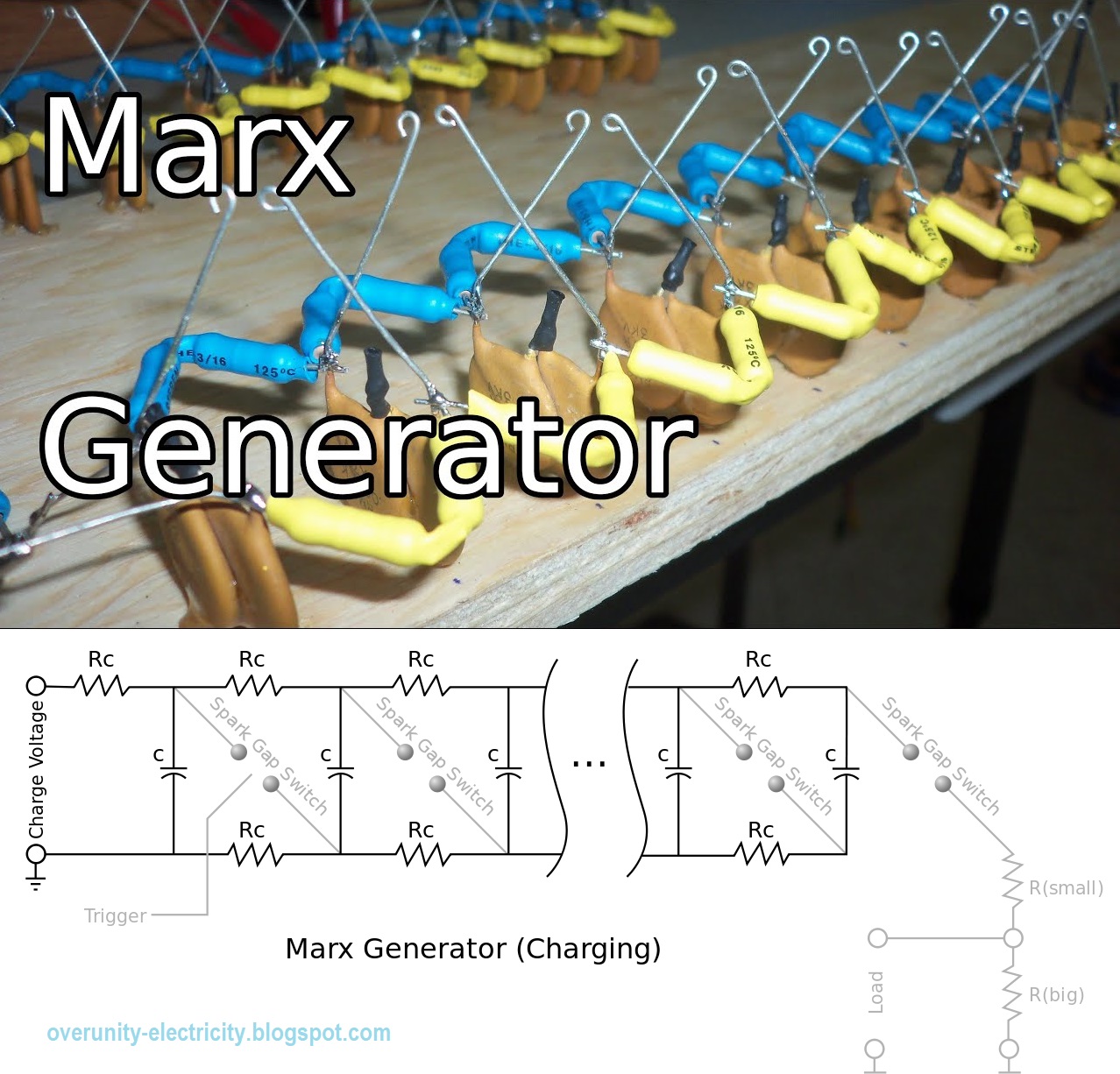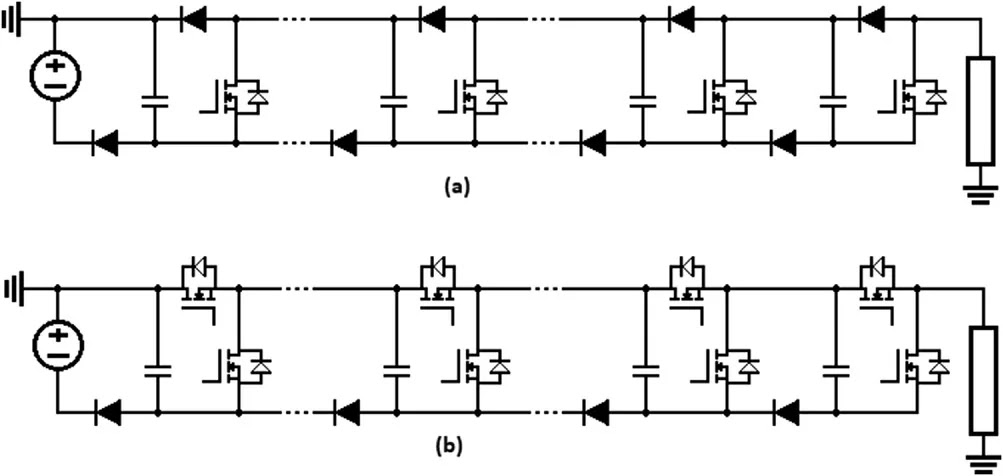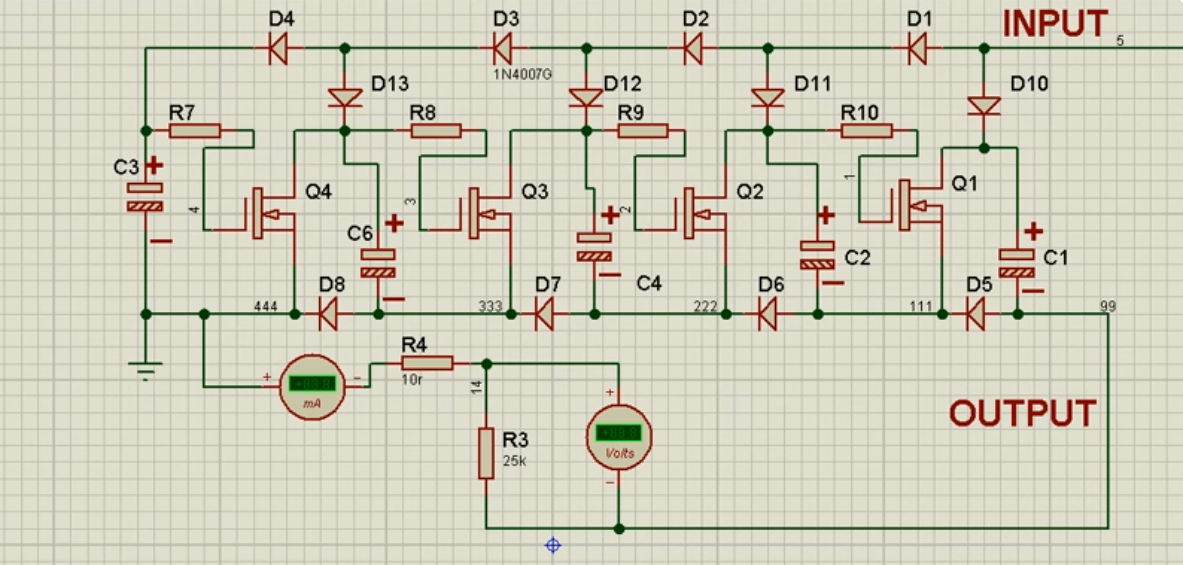1. Marx Generator Theory
The Marx generator is an electrical circuit first described by Erwin Otto Marx in 1924. Its purpose is to generate high voltage pulses from a low voltage DC power source.
Schematic diagram of a Marx generator, a high voltage circuit used in insulation testing and scientific research. It generates a pulse of high voltage by charging multiple capacitors in parallel and then suddenly connecting them together in series by spark gaps. The capacitors are charged by the resistor network. Although the left capacitor has the greatest charge rate, the generator is typically allowed to charge for a long period of time, and all capacitors eventually reach the same charge voltage.
Marx generator: Circuit diagram and actual model are homemade
The DC power source, such as a battery with a voltage value denoted as Vq, is used to charge a series of capacitors. Once fully charged, the voltage across the capacitors matches that of the charging source.
Next, a trigger method is employed to increase the voltage across the first capacitor, resulting in a breakdown voltage. This causes the immediate passage of plasma flow through the spark gap.
This plasma discharge, seen as an electric spark, takes on a special dielectric form as it's released into the surrounding air environment. At this point, the circuit is closed. However, since the spark occurs very quickly, the tension established in the capacitor is not fully discharged. Consequently, this is akin to a closed circuit being abruptly cut off.
In this scenario, resistance is best expressed by its inverse, conductivity, which becomes zero. As the current vanishes instantly, the electromagnetic field (EMF) decays almost at the speed of light. Because EMF is directly linked to the velocity of magnetic flux, 'i' (current) tends toward infinity. This results in very strong effects as the field strives to maintain the current by generating whatever EMF is required.
A high voltage, denoted as Vs, naturally emerges due to the attempt to sustain current flow by generating any necessary EMF. Vs charges the capacitor more substantially than the initial source charge, with Vs having a value many times larger than Vq (Vs >>> Vq). Vs can reach several tens of thousands of volts.
This voltage, Vs, possesses sufficient power to charge the entire series of capacitors connected in parallel to each other. Thus, when Vs charges the adjacent capacitors, it reaches the breakdown voltage threshold, causing a series of spark gaps to discharge into a closed circuit instantaneously.
After a plasma discharge process through the spark gap, the capacitors remain in a state of full tension according to the threshold index recorded on the capacitor. The total voltage of the entire circuit is calculated based on the highest total voltage among the capacitors (V max).
This circuit's ability to generate a significantly high voltage from a very low voltage battery source is a remarkable feature.
Note: The super high voltage phenomenon of the Marx Generator cannot be explained using today's mainstream electrical theory.
The aforementioned explanation also outlines the operational principle of the Marx Generator. The theory that elucidates this is known as the Ether Field Theory.
Is this Theory Reliable? This theory is relatively obscure, known to few. It was articulated more clearly by Charles Proteus Steinmetz and J.J. Thomson in the early 20th century. Notably, Charles Proteus Steinmetz was tasked by corporations with deciphering Nikola Tesla's inventions.
Both Nikola Tesla and Charles Proteus Steinmetz existed on the fringes of mainstream scientific discourse, as corporations sought to safeguard their technological monopolies.
Charles Proteus Steinmetz's writings are still preserved in archives and can be studied. They offer a profound understanding of the Ether Field Theory for electricity. Presently, Eric P. Dollard, Ken Wheeler, and other researchers possess a clear comprehension of this theory.
The mathematics used in Marx Generator development relies on the Ether Field Theory of electricity postulated by Steinmetz and Nikola Tesla. Today's electrical theory employs mathematical quantification but adapts older formulas from Ether physics, built around the concept of dielectricity. The physical formulas for mainstream electrical theory closely resemble those from older physics but incorporate alterations in fundamental concepts such as current, voltage, laws of magnetism, and Coulomb's force.
To properly and accurately understand the Marx generator, you need scientific theories from the following 4 + books:
Thomson, Joseph J. Electricity and Matter. New York: Scribner, 1904.
Steinmetz, Charles P. Elementary Lectures on Electric Discharges, Waves and Impulses, and Other Transients. New York: McGraw-Hill Book Co., Inc, 1914.
Steinmetz, Charles P. Theory and Calculation of Transient Electric Phenomena and Oscillations. New York: McGraw-Hill Book Company, Inc, 1920.
Note: If you look closely at Nikola Tesla's technology and free energy, it can be seen that the Marx generator produces free energy if improvements are added! This is similar to Nikola Tesla's Transformer, which also produces free energy if a little modification is added to exploit the high voltage at the output: Free Energy From Tesla Coil - Tesla Transformer Become Generator!
If you don't want to read the Ether books above, The Theory explains how the Marx generator works based on this brief summary by Eric P. Dollard:
INSTANT ENERGY RELEASE AS INFINITY
Very interesting (and dangerous) phenomena manifest themselves when the current path is interrupted, thereby causing infinite resistance to appear. In this case resistance is best represented by its inverse, conductance. The conductance is then zero. Because the current vanished instantly the field collapses at a velocity approaching that of light. As EMF is directly related to velocity of flux, i tends towards infinity. Very powerful effects are produced because the field is attempting to maintain current by producing whatever EMF required. If a considerable amount of energy exists, say several kilowatt hours* (250 KWH for lightning stroke), the ensuing discharge can produce most profound effects and can completely destroy inadequately protected apparatus.[* The energy utilized by an average household in the course of one day.]
2. Solid-State Marx Generator
Understanding the Marx Generator's nature, as explained by the Ether Electricity Theory, led to the innovation of replacing the spark gap with semiconductor devices, resulting in the creation of the Solid-State Marx Generator (SSMG).
Semiconductor devices and power electronics concepts drove the development of Solid-State Marx Generators (SSMGs), granting them the capability to modulate pulses flexibly.
If the goal is to generate high voltages, regardless of the shape of the high-voltage pulse signal, the classical method can be employed. The Solid-State Marx Generator (SSMG) is available in various versions, catering to the field of desired signal modulation.
High-speed high-voltage solid-state Marx generator based on SiC MOSFETs
Solid-State Marx Generator by MOSFET / IGBT
Marx generators employ multiple identical stages to generate high-voltage pulses while operating at a fraction of the total output voltage. This unique approach eliminates the need for a step-up transformer, thus limiting rise times and preserving system performance. Each Marx stage comprises a capacitor or pulse generation network paired with a high-voltage switch, often in the form of spark gaps. Consequently, traditional Marx generators exhibit low repetition rates and a restricted operational lifespan. However, advancements in cost-effective, compact, high-voltage, high-di/dt, and fast-on solid-state switching devices have revolutionized the fabrication of Marx generators, making them more economical, durable, and capable of delivering high-pulse repeatability.
One notable example is a Marx generator we constructed, utilizing 24 kV thyristor-based switches capable of conducting a peak current of 14 kA. These switches enable a bell discharge at a rate exceeding 25 kA/mus during the current rise period, with a short turn-on delay of less than 200 ns, minimal timing jitter, and activation via a 10 V isolated trigger pulse. In the following sections of this article, we will delve into the four-stage Marx solid-state system and its trigger mechanism, along with a presentation of operational data obtained at a 15 kV charging voltage. The Marx generator plays a crucial role in controlling a single-stage argon ion accelerator.
3. Marx Generator in Russia
Erwin Otto Marx (1893–1980) was a German electrical engineer who invented the Marx Generator. The Russians, in the realm of Russian science, developed their version of the Marx Generator in a mysterious forest, a fact that has piqued considerable interest.
Conspiracy theories abound, suggesting that the Marx Generator, in conjunction with Nikola Tesla's technology, played a role in the Tunguska explosion. This intriguing conspiracy theory has generated significant interest in the Marx Generator in Russia.
Below is a video detailing an expedition into the forest to explore the Marx Generator in Russia:
Investigate (explore) the Marx generator in the Russian forest
Finally, we recommend:
The free energy generator is essentially the same as the process in the Marx generator: Testatika Generator - Free Energy by Impulse Technology
Free energy is mentioned frequently by the forum on Subreddit r/plasma_pi: 🔎 Top Magnetic Generator
Revealed At Last... Must watch!
Free Energy Magnetic Generator and synthesizes many other technologies imbued with Nikola Tesla's technological identity
✔ Nikola Tesla’s method of magnifying electric power by neutralizing the magnetic counter-forces in an electric generator
Generates Energy-On-Demand: 👉 Free Energy Will Change Our World Forever
✔ Combination of induction motor and alternator
✔ Combine generators with induction motors - self-powered generators with rotary motion
✔ Various methods of generating high power immobile generators
✔ Or maybe called Overunity for the system. Mother Nature doesn't care about people calling or naming phenomena. Overunity/Free Energy, Zero Point Energy (ZPE) are just a few different words


